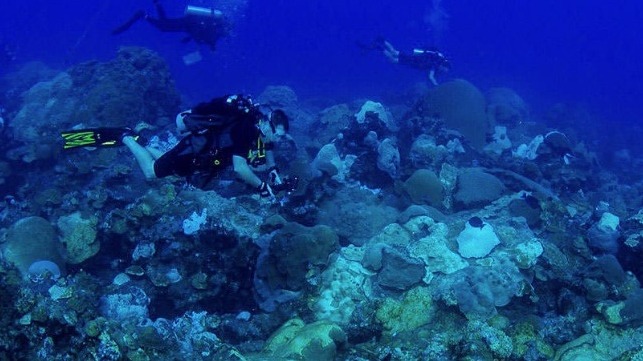Watching for Changes in Marine Biodiversity

Changes in marine biodiversity—the variety and variability of life in the ocean—can be an early indicator of change, provided it's noticed. The U.S. Marine Biodiversity Observation Network (MBON) aims to ensure that scientists not only notice changes in biodiversity at locations around the nation, but also have the tools in place to better understand what these changes tell us about ocean health over time. But marine life doesn't know borders. That's why the U.S. network also supports international cooperation with other marine biodiversity networks, research institutions, governmental and non-governmental organizations and stakeholders around the world towards development of a truly global MBON.
One of the best ways to understand how our ocean is changing is to closely monitor the health and diversity of marine life. Armed with this knowledge, researchers and resource managers can better track the health of ocean ecosystems. This, in turn, helps us make better decisions to protect marine resources and support the people and businesses who depend upon the ocean for their lives and livelihood. But monitoring marine life is no easy task. Through the U.S. Integrated Ocean Observing System, NOAA, NASA, the Bureau of Ocean Energy Management and the Office of Naval Research are developing a marine observation network for the United States to create a better long-term system to monitor changes in marine life.
U.S. MBON project managers are hard at work across the country integrating historical and current biodiversity data with new observations, and expanding application of modern approaches with traditional environmental research tools and coordinated experiments. Together, these efforts are helping us understand the impact of a changing environment on marine and human life. U.S. MBON also works to standardize methods and best practices to quantify relationships between climate, the ocean environment and marine food web — from microbes to top predators — to help us predict how a marine ecosystem might respond to environmental change.
At the same time, U.S. MBON researchers are growing relationships with marine biodiversity networks around the world. Why? The ocean doesn't recognize borders. While NOAA and partners are working to strengthen local and regional networks in the U.S., researchers are also looking past our nation's borders to help ensure marine life data is shared around the globe.
In 2016, MBON was officially declared a thematic node within the Group on Earth Observations Biodiversity Observing Network (GEO BON). The first major undertaking of this group was to establish MBON Pole-to-Pole, an initiative to link regional observing networks in the Atlantic and Pacific to create an integrated picture of ocean status from the Arctic to the Antarctic. MBON Pole-to-Pole is now beginning work in the Americas region, with representation from U.S. MBON and participants from Argentina, Brazil, Chile, Colombia, Mexico, Ecuador, Peru, Uruguay, Venezuela, and Canada.
Case Study: MBON in the Gulf of Mexico
When an unprecedented coral mortality event hit Flower Garden Banks in the summer of 2016, MBON took action to help unlock the mystery. Once the dying coral was spotted, Frank Muller-Karger, MBON Principal Investigator and Director of the Institute for Marine Remote Sensing (IMaRS) at the University of South Florida, analyzed historical satellite data of the region and researchers identified unusually high levels of chlorophyll in the water around the affected coral.
This, in turn, indicated unusually high runoff from the Mississippi Delta — which makes sense in the wake of higher-than-normal summer rains in the southern U.S. The runoff extended all the way to sections of the reef, and may have brought with it organic deposits and decreased light penetration that may have triggered a number of deadly consequences such as bacteria or pathogen growth. While scientists continue to work to identify the coral killer, biological observations provided the first lead.
Case Study: MBON in the Arctic
Intensive field studies conducted by the Arctic MBON (AMBON) team in 2017 provided essential data for a study to understand accelerations in warming starting that year and associated ecosystem effects. The work was published in the journal Nature Climate Change by the AMBON team in collaboration with other research programs in the Chukchi Sea. The study establishes that these recent changes can result in major reorganization of the Arctic ecosystem and may indeed represent a “new normal” for Arctic shelf systems to now function more like sub-arctic systems.
In addition to dramatic increases in bottom-water temperatures as well as changes in sea phenology, the study found altered timing and magnitude of spring-ice-associated phytoplankton and zooplankton blooms and higher frequency of toxic algae blooms (HABs). Key zooplankton species that play vital roles in energy transfer in the Chukchi Sea decreased dramatically in abundance in 2017, as did epibenthic invertebrate biomass, which dropped by an order of magnitude in 2017.
Some sub-arctic species, such as pink salmon, expanded northwards and experienced strong increases in these past years, changing predator-prey and interspecific competition patterns in the region. Some seabird species experienced unprecedented reproductive failures and die-offs, [presumably from malnutrition. Northward expansion of wintering grounds and earlier reproduction has also been observed in 2017 in bowhead whales.
All these changes also have strong human repercussions for Arctic peoples. Winter ice is no longer safe for travel and traditional subsistence hunting times and species are changing. It is possible that the entire social-ecological system has passed a threshold that substantially reconfigured ecosystem functioning from which it may not easily return due to positive climate feedback mechanisms.
The opinions expressed herein are the author's and not necessarily those of The Maritime Executive.
